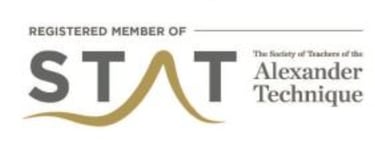Learning the Alexander Technique is a journey into the nature of habit. How we physically and mentally reaction to a stimulus.
Forming habits is neither a good or bad thing, but if our responses are not appropriate for the circumstances, if they remove any chance of natural spontaneous reaction or considered response, then they act as a prison to the physical body.
Under stress we enter the fight, flight or freeze mode. An emergency requires the body to go into automatic self protection and our ability to think rationally is restricted. This would be fine if these situations were black and white and encountered only occasionally, but modem life is so full of stimulus that many are held in a situation or perpetual freeze.
Traumas we encounter in life can lead us to reside in our heads so we can feel safe in ruminating on past encounters or make plans for imagined future disasters. The problem this creates is that the nervous system does not distinguish between real and imagined dangers and as a consequence the fight, flight and freeze response gets permanently engaged.
In the Alexander Technique we confront this head on, but instead of talking about past traumas we look at how we respond to a stimulus to act and how it affects the nervous system. People tend to over-react and grip themselves too tight when faced with the need to respond to a stimulus. Even something as small as reaching for a phone or standing up. Slowing down and observing this, is the only way you can see your thoughts as they transition into activity. This pausing we call inhibition. The ability to choose not to respond when everything inside us tells us we need to.
FM Alexander made an interesting comment about this, one which an AT student will readily relate to:
Boiled down, it all comes to inhibiting a particular reaction to a given stimulus. But no one will see it that way. They will see it as getting in and out of a chair the right way. It is nothing of the kind. It is that a pupil decides what he will or will not consent to do. They may teach you anatomy and physiology till they are black in the face – you will still have this to face: sticking to a decision against your habit of life.
FM Alexander (“Articles and Lectures” – Teaching Aphorisms p203)
A person who comes for an Alexander Technique lesson has usually aquired a lifetime of unhelpful habits, and those habits have embodied themselves so strongly that muscles and joints have become held in place and are causing pain. Trying to overlay new habits does not really help. Many people usually start attending AT lessons after weeks or months of trying Pilates, Yoga and physio exercises, but these may have even re-enforced old movement patterns and made things worse in the process.
So the Alexander Technique teacher patiently works with a client to help identify their old habits, and in a non-judgemental gives the opportunity to let them go. Getting in and out of a chair, squatting, walking etc are ways of getting a person to notice the thoughts associated with the habitual movement and to see if they are really appropriate.
Its about choice, or at a deeper level freedom as an individual. It's a a method of seeing habits, making them conscious and allowing the freedom to change and adapt them as necessary. That's not just about moving in and out of a chair, it's about how you react to an argument, an accident, how you mow your garden or even how to plan and think about all the things that confront each of us in life.
Habits are formed in the brain, they may be helpful and let us live in a complicated environment, but they can also act as a prison to development and free expression. Alexander's discovery was unique as it not only identifies the door out of the prison but also offers us the key to open it. It all starts with the decision to STOP.



